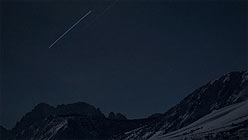As teenagers we would lie on our backs in East Bay parks and wait for the meteor shower to begin. Other summer nights my friends and I sat in suburban backyards, trying to pinpoint the Pleiades with our fingertips. We looked up because we were attracted to the sky: its mystery and possibility. And we clumsily tried to identify constellations, lying in the dirt waiting for shooting stars, because we longed to know and understand a small piece of its vastness.
Trevor Paglen’s current exhibition at the Berkeley Art Museum, The Other Night Sky, reflects both of these impulses — the urge to wonder and the urge to know. An artist and geographer (he receives his PhD in the latter subject this summer), Paglen overlaps these two approaches in his work. He uses photography, once believed to be an objective tool of documentation, to highlight the limitations of sight, and by extension, knowledge. He aims his lens at obscured buildings, indistinct shapes, and unintelligible landmarks. One of his bodies of work involves photographing top-secret U.S. military bases in the Nevada desert from up to fifty miles away. The resulting images are like infrared landscapes; we can only stare at the colors and wonder what it is we are unable to see, trying to imagine the object that has eluded documentation.
The subject of The Other Night Sky is government satellites, their prevalence and position in the sky. The eleven photographs and single installation call attention to these intruders, indistinguishable from stars or planets, orbiting and watching all that goes on below. The photographs resemble pages ripped from middle-school science books: a black or blue background with small specks of red, yellow, and white light, forming clusters and outlines of shapes. Keyhole 9-19, Near Vega, DMSP-2 in Ursa Major, Alex near Kappa Cassiopiea. Cryptic titles are attached to each star-field. Standing in the gallery, I read each satellite’s name and location and then look back at the photographs. But I have no better understanding. Each piece of sky is still indistinguishable from the next.
“The images don’t tell you anything,” Paglen said when I called to ask him about his work. “You can do all this work and it’s just a little streak in the sky,” he said. Using scientific language and precision to produce such ambiguity creates a kind of poetry, he added. I felt it at times, walking from photograph to photograph, saw it flash for an instant: that slippery place where science falls in on itself and something else shines through.
At the rear of the gallery, behind a black curtain, the show’s single installation — its highpoint — hides. Active Military-Reconnaissance Satellites of the United States is a large silkscreened globe, illuminated from within. Four slide projectors are positioned at the room’s corners, shining moving yellow dots across and around the sphere. A breathy noise plays in the background, similar to the sound of someone listening in on your phone call. The moving dots depict actual satellite locations; the ambient noise is sound from intercepted satellite transmissions. But the satisfaction I felt upon looking at the installation didn’t come from any information it provided. It came because I felt like I had walked into a child’s bedroom; a 6-year-old was hiding beneath the blankets with a flashlight in hand, casting shadows on the walls and making up stories about aliens.


